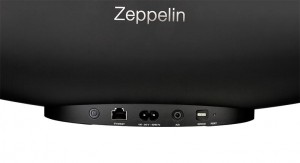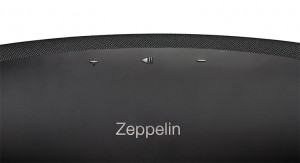Our Verdict – 5 Stars
Building on the beloved range’s sterling reputation, the Wireless is the best Zeppelin yet
For:
Large spread of sound
Precise soundstage
Expressive mids
Stays composed at higher volumes
Seamless control and design
Good functionality
Against:
No Android app
Midrange could be more authoritative
Reviewed on 17th March 2016
B&W has cemented its commitment to the wireless speaker market in the last few years with the five-star premium A5 and A7 AirPlay models, and the portable T7 speaker. However, the brand’s Zeppelin line is perhaps its biggest success story.
It all started eight years ago. The original Zeppelin marked the brand’s first foray into the powered one-box speaker market, spawning the equally impressive Zeppelin Mini in 2009, and Zeppelin Air in 2011.
Just when we thought the beloved range had succumbed to the brand’s more conventional-looking entries, the Zeppelin Wireless arrives to make its mark – and with an almighty bang indeed.
B&W couldn’t well tamper with the airship-shape and keep the legendary moniker going so the iconic design returns – the Wireless simply gains a couple of centimetres here and there.
With some speakers resembling beach balls, it doesn’t seem quite so offbeat anymore. Instead its elegant, stylish look proves timeless.
Features
While it would be easy to underestimate the work that’s gone into the Wireless based on its appearance, it would be a great injustice as beyond the chassis almost everything else has been entirely reworked.
Behind the elliptical front panel are five new drivers: two 25mm metal dome tweeters, as found in the company’s CM Series speakers, and a pair of midrange drivers which, featuring FST technology borrowed from the flagship Diamond 800 Series, use a foam surround instead of a conventional one to improve damping. They also feature anti-resonance dust caps for a cleaner, smoother response.
Taking centre stage on the baffle (now double the thickness to reduce vibrations and strengthened with glass fibre ribs, by the way) is a single 15cm woofer – the same size as the one found on the flagship A7.
Save for a few upgraded components the power amplification stage is largely the same, each driver powered by a Class-D amplifier. B&W claims that the digital signal processing is now twice as powerful for more accuracy too.
That’s pretty tech-heavy stuff for a £500 wireless speaker, but if an established stereo speaker company like B&W wants to repackage some of its flagship technology and most impressive engineering into a smaller, more modest offering, who are we to argue?
Build
Sensing the end of an era, the Zeppelin Wireless ditches the front-facing Apple dock, so Apple users don’t need to hand over their iPhone or iPod anymore.
A direct connection to a smartphone or tablet can still be made via its 3.5mm input, but the Zeppelin’s focus is very much on wireless connectivity – through AirPlay, aptX Bluetooth or Spotify Connect.
Design-wise, it’s the most seamless-looking of the Zeppelins, and not just because it doesn’t have a device sticking out of it. A small brand badge, which protrudes from the shapely chassis, doubles as a neatly discreet control touch panel.
Touch the right hand side of it for two seconds to initiate Bluetooth pairing, tap the other side to switch to the 3.5mm input. It’s wonderfully simple.
Set-up is facilitated by the updated Bowers & Wilkins control app, which works a treat and gets you up and running in no time. You can download it on a Mac, PC or iOS device, but there’s no Android version.
The only other things to get acquainted with are three buttons on the top for volume and play/pause; ethernet, power and auxiliary sockets around the rear; and a service-only type-B USB slot.
Sound
The Zeppelin plays and upscales to 24bit/192kHz so a 96kHz file of Muse’s Supremacy over Bluetooth seems like a good place to start.
The B&W’s physical wide girth helps to create an expansive, sweeping spread of sound that doesn’t struggle filling our largest test room nor overpower our smallest one; close your eyes and it’s easy to imagine that the song’s epic orchestration is blaring from two speakers.
It doesn’t just throw out a big display but also a precise and well-imaged one that stays composed no matter how hard you push up the volume.
The Zeppelin Air impressed most with how tight and defined it was in the bass and that proves one of the Wireless’ biggest charms too.
The track’s big walloping drums are lathered with punch and power, and the rolling drumbeat slaps with vengeance underneath the vocals.
Convincingly organised and with a precise ear for rhythms, the B&W stays coherent and coordinated even in the dense orchestral climax. It’s pricier competition show it up in absolute timing but it’s plenty agile for its level.
Take the intensity down to a simple vocal and guitar accompaniment – this time Eva Cassidy’s Fields of Gold – and you can really appreciate the transparency of the midrange. Her soaring vocals are given free reign in the soundstage, with all her subtle outbursts and trail offs accounted for, and there’s a strong sense of tactility to the acoustic strings.
Move onto Eminem’s rap vocal in Bad Guy and it almost sounds like an assault, the venom in his delivery and the dynamics of his quirky structure laid bare.
There’s no shortage of clarity and insight at this price then, but we would perhaps like a touch more solidity through the midrange to give the Zeppelin just a little more authority.
As the onslaught of distorted guitars comes in, there’s heft behind each precise string strum and in the same breath enough insight to hear every tremor in its diction.
The Zeppelin isn’t all about the big picture, putting its finger on the finer details too. The dramatic raptures of violins pull through with clarity and texture in spades.
When compared with something like the £595 Naim Mu-so Qb, it uncovers a hint of fragility and leanness to the Zeppelin that its pricier competitors are able to avoid.
There’s also a slight dip in sound quality playing songs over AirPlay, most notably in clarity and subtlety. Compared to Bluetooth and Spotify Connect, it makes music feel a little closed-in too.
That said, even a low-res Spotify stream of Pink Floyd’s Another Brick in the Wall Pt 1 sounds surprisingly informative – start your Zeppelin journey here and you’ll be surprised what you’re hearing is a 320kbps compression.
The Zeppelin Wireless keeps the range’s legacy alive, combining a highly accomplished sound with greater functionality and an even more seamless design.
Verdict
It’s not often a product – let alone something as prolific and short-lived as a wireless speaker – has such timelessness, but here we are eight years on and the Zeppelin speaker is still a great option at its price.
More expensive speakers might have more to offer when it comes to timing, drive and overall authority, but at £500, this is one of the most talented wireless speakers we’ve heard.
Read more at: http://www.whathifi.com/bw/zeppelin-wireless/review
Where to buy B&W: http://abtec.co.nz/product-search.php?keyword=zep&category=&brand=&search=






